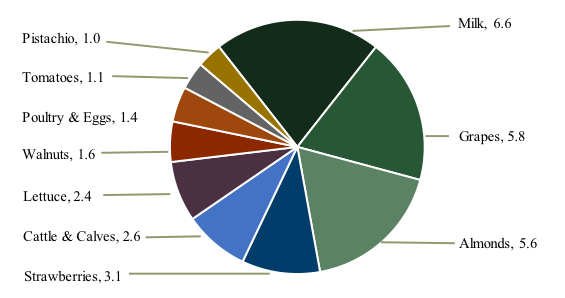July 30, 2019
This article will be featured along with other articles addressing agriculture investment opportunities and surrounding themes in the GAI Gazette, Volume 6, Issue 4, which will be distributed in conjunction with the 10th annual Global AgInvesting Europe event, to be held in London on 9-10 December 2019. Join us in London to hear valuable insight and best practices from the expert speaking faculty. Learn more and register.
By Molly Saso, Hancock Farmland Services, and Dan Serna, Hancock Natural Resource Group
Irrigated agriculture is one of the largest consumers of water supplies in most water basins in the United States; government-backed research shows that irrigated agriculture is responsible for over 75 percent of annual consumption in these basins.[1] Groundwater is a vital component of available water supplies. In California, groundwater aquifers provide nearly 40 percent of water used by farms and cities on average, with significantly higher usage percentages in drier years.[2]
Agriculture is the state’s largest consumer of groundwater, creating tension in local areas when pumping begins to impact local groundwater supplies and quality.
The Impact of SGMA
The passage of the Sustainable Groundwater Management Act (SGMA) in 2014 significantly changed the landscape for water use in California, especially for irrigated farmland. SGMA defines a framework for sustainable use of groundwater that aligns water use with available water supplies. The framework must include water budgets, minimum thresholds, measurable objectives, and programs and actions, along with procedures to track success over the 20-year implementation period. In most areas, programs and actions will consist of a combination of water market programs, projects that augment surface water supplies, and reduction in demand (and pumping) through conservation and land fallowing.
As noted above, on average, underground aquifers provide nearly 40 percent of the water used by California’s farms and cities, and significantly more in dry years. California benefits from having one of the largest surface water storage and conveyance systems in the world, yet farms have grown increasingly dependent upon groundwater in recent years, due to reductions in available surface water supplies to meet environmental and water quality objectives, including preserving endangered species. Investment in increased surface water storage and conveyance capacity has lagged in recent decades for a number of reasons, such as lack of funding support from traditional state and federal agencies, political opposition, endangered species act demands, and high cost with limited certainty as to long-term benefits.
About 85 percent of Californians depend on groundwater for some portion of their water supply. Some communities rely entirely on groundwater for their drinking water, and groundwater provides a critical resource for many farmers in the Central Valley and Central Coast regions.[3] The California Department of Water Resources and the Public Policy Institute of California (PPIC) estimate that overdraft (where groundwater use exceeds the amount of recharge) in the Central Valley ranges from 1.5 to 2.0 million acre feet[4] per year, with most of that overdraft falling in the San Joaquin Valley. SGMA requires elimination of that overdraft by 2040 and does not allow the degradation of water quality. Even with capture and storage of additional surface water flows in wetter years, PPIC estimates that land required to be taken out of production to eliminate overdraft in the San Joaquin Valley could reach approximately 500,000 acres upon full implementation of SGMA.[5]
California leads the U.S. in agricultural production value at $50.3 billion, producing nearly double the revenue of second-place Iowa.[6] In 2017, California agricultural exports totaled $23.1 billion, comprising 17 percent of total U.S. agricultural exports of $138.2 billion.[7] Alfalfa production and other forage crops, while not high in overall market value, provide an important input to the state’s dairy and other animal agriculture production.
2017 California’s top-10 valued commodities (ranked by total farm-level sales in USD billion)[8]

Counties within the San Joaquin Valley (Fresno, Kern, Kings, Madera, Merced, San Joaquin, Stanislaus, and Tulare) typically rank among the top counties in the nation for agricultural production. In addition to contributing significantly to county and state gross domestic product (GDP), the agricultural production, processing, and transportation sectors in these counties generate additional employment, creating a significant multiplier effect. In the counties of Fresno, Kings, Madera, Merced, and Tulare, agriculture directly comprises about 25 percent of total GDP and 17 percent of total employment, not including food processing and supporting agribusinesses.[9]
As a result, water is a critical resource to the continued viability of the state’s agricultural products and overall economy. About one-tenth of California’s total area, or nearly 10 million acres, is irrigated farmland, and more than five million of those acres are in the San Joaquin Valley. Properties with abundant surface water are best positioned to respond to SGMA’s requirement to reduce groundwater use to sustainable levels. Lands entirely dependent upon groundwater will likely be most negatively impacted.
HNRG Responds with a Plan
Hancock Natural Resource Group’s (HNRG) client farmland property portfolio in California consists of over 80 ranches covering approximately 66,000 acres in 19 counties. These properties fall in over 30 groundwater sub-basins, most of which will be required to comply with SGMA. On behalf of HNRG clients, Hancock Farmland Services (HFS), HNRG’s fully-integrated agricultural property manager, has conducted an assessment of potential risk and opportunity for each property based on the water supply estimated to be available upon full implementation of SGMA. The assessment determined that approximately 50,000 acres, located in 12 groundwater basins in seven counties, should be designated as “priority” areas for focused monitoring and engagement in the Groundwater Sustainability Plan (GSP) development process to support operational decisions involving future water and land use. The initial assessment concluded that water supply for approximately one-third of the 66,000 acres is “balanced,” meaning currently forecasted water supplies for 2040 are expected to be sufficient to meet current crop demand. The remaining two-thirds of the total HNRG client acreage is forecasted to require action to prevent water deficit as defined by SGMA in 2040, ranging from a one acre-foot deficit to over two acre-feet deficit in certain areas.
In responding to the challenges that SGMA presents, HNRG and HFS have, to-date, employed a two-pronged approach. First, at the policy level, they have leveraged their experience as stewards of natural resources by creating alliances with like-minded farmers, land owners, and other agricultural interests to develop policy objectives and processes relative to the creation of the required GSPs. Through this leadership, HNRG and HFS strive to develop policies and solutions that benefit all farmers, regardless of farm size. Second, guided by these policy objectives, they have worked with local agencies engaged in creating these plans, providing input and direction as a key stakeholder in the process. In one circumstance, further discussed below, HFS managers engaged with local landowners to form the Triangle T Water District, which is now developing surface water supplies and preparing the local GSP to achieve sustainable management of groundwater.
HNRG’s farmland portfolio management will continue to evolve in response to SGMA implementation. Building upon HNRG’s water conservation commitment, various projects and actions are already underway as part of this evolution. These actions include, but are not limited to: (1) flooding farmland with flood release surface water to recharge groundwater basins; (2) evaluating riparian surface water rights on certain properties for in-lieu (indirect) and/or direct recharge; (3) allowing local water districts to use HNRG managed properties for recharge of surplus district water supplies; (4) acquiring additional surface water from willing sellers; and (5) setting land aside during development and redevelopment processes to balance demand with available water supplies and to create wildlife habitat, and develop alternative energy sources while enhancing safety (through buffer zones and flood water management) and water recharge benefits.
With Implementation, New Opportunities
The intent is to improve water supply reliability and quality, while maintaining farming viability within the portfolio, and contributing to sustainable groundwater management objectives. As property development and redevelopment decisions are considered, HNRG/HFS evaluates water supplies, crop options, alternative land use scenarios, and other opportunities. Fallowing of lands may be required in areas with limited groundwater and surface water supplies. Strategic fallowing presents opportunities for groundwater recharge, solar development, recreation of floodplains, and habitat creation. In many cases, these alternative land uses are mutually compatible, and incorporating them into the portfolio can benefit both property and environmental value, mitigating the impact of fallowing acreage. Restrictions in groundwater use through pumping limitations are expected to be phased in over time in many groundwater basins, given the requirement to reach sustainability in 2040. HNRG believes its participation in the development of regulatory policies and processes related to SGMA, and a willingness to lead while working cooperatively and creatively, are essential to optimizing sustainability and minimizing risk of these long-term investments.
Engagement Leads to Formation of New Water District
An example of proactive engagement with SGMA is HFS joining with local landowners to form the Triangle T Water District (TTWD) to address water supply challenges and localized subsidence in the Chowchilla groundwater sub-basin. TTWD includes the Triangle T Ranch, an HNRG managed client property that has historically relied on pumping irrigation water from the property’s deep aquifer at levels inconsistent with SGMA. Given the impact of SGMA, TTWD elected to prepare a GSP under SGMA in coordination with other public agencies in the sub-basin. Since its formation in 2017, TTWD has worked with local landowners and neighboring water agencies to develop a multi-part plan to decrease deep aquifer pumping and decrease subsidence rates. Elements of the plan include:
– The purchase of new surface water supplies from willing sellers, capturing flood flows and recharging the shallow aquifer,
– Establishing grower-managed fallowing programs to decrease demand and allow for direct and in-lieu groundwater recharge,
– Expanding local distribution systems and annexing neighboring lands into the TTWD service area. TTWD is working with other local agencies to develop financial support for the region through a California Office of Emergency Services (OES) Grant that will support projects that minimize local hazards from flooding, drought, subsidence and climate change.
Quantifying Initial Results
Positive results for the region and for the Triangle T Ranch in both water supply and reduced groundwater subsidence are already being achieved through recharge of the shallow aquifer and decreased pumping from the deep aquifer, demonstrating the benefits of active management of the basin by the HFS team and providing a proven tool for others.
– In 2017, Triangle T Ranch and its neighbors sunk 68,000 acre feet of flood water into recharge (estimated 20,000 to 35,000 acre feet on Triangle T itself).
– In 2018, Triangle T irrigated with excess floodwater, captured and then sunk the remaining balance of 183.41 acre feet into recharge.
– In 2019, to date, Triangle T ranch has put 1,806.69 acre feet into recharge, net after irrigation use.
In summary, SGMA requires recharge of underground aquifers in California’s agricultural regions through reduced pumping rates and other means to bring aquifers to a sustainable level for the long term. Water supply, quality, and risk in California vary across both regions and individual properties. Water risk depends on several factors, including the groundwater basin and irrigation district in which the property is located, whether the property is able to access multiple sources of water, and the tools available to the property or to Groundwater Sustainability Agencies (GSA) to offset groundwater pumping effects.
Proactive Response Enhances Long-Term Outlook
Given these factors, it is HNRG’s view that in the coming years, some properties in California may see declines in value, while others may maintain or increase value, depending on the specific property impact from SGMA and depending on how respective land owners and property managers respond to that impact. Growers willing to fallow ground or flood crops for recharge with excess water, when available, can enhance replenishment of groundwater in years with excess surface water, thus leveraging available natural resources to solve a problem. Scaling this solution could help growers comply with SGMA and preserve agriculture, while conserving water for the state as a whole. A key to success will be having a comprehensive and flexible approach that spans from the state policy arena to farm-level operations.
In HNRG’s view, California remains a viable and vital region for investment in permanent crops; the state provides unparalleled climates and soils to produce the highest quality and yields of crops. The implementation of SGMA will ultimately demonstrate that, with appropriate expertise, technology, and collaboration on sustainable methods, California water resources can be utilized now and in the future to sustainably grow crops that contribute to satisfying global food demand.
SOURCES
[1] Brown, T. C., Mahat, V., & Ramirez, J.A. (2019). Adaptation to Future Water Shortages in the United States Caused by Population Growth and Climate Change. Earth’s Future, 7, 219–234. February 2019. https://doi.org/10.1029/2018EF001091.
[2] California Department of Water Resources and the Public Policy Institute of California (PPIC), Groundwater in California, May 2017. https://www.ppic.org/publication/groundwater-in-california/
[3] Ibid.
[4] An acre-foot is a unit of volume equal to the volume of a sheet of water one acre (0.405 hectare) in area and one foot (30.48 cm) in depth; or 43,560 cubic feet (1,233.5 cu meters).
[5] PPIC, Water and the Future of the San Joaquin Valley, February 2019.
[6] USDA ERS, as of March 6, 2019, using 2017 data. https://www.ers.usda.gov/data-products/farm-income-and-wealth-statistics/data-files-us-and-state-level-farm-income-and-wealth-statistics/ (See March 6, 2019 downloadable release, 2017 data.).
[7] USDA ERS, as of June 2, 2019, using 2017 data. ERS State Agricultural Exports, U.S. agricultural cash receipts-based estimates (Calendar years) https://www.ers.usda.gov/data-products/state-export-data/state-export-data/#State%20Agricultural%20Exports,%20U.S.%20agricultural%20cash%20receipts-based%20estimates%20(Calendar%20years) (See downloadable file 2000-2017.).
[8] Ibid.
[9] Konduru, Srinin, Todd Lone and Ryan Jacobson, Agriculture in Central California, Central California Business Review, February 2018.
About the Authors
 Molly Saso, water resource manager at HFS, is responsible for managing water assets for HNRG’s roughly 66,000 acres of California farmland under management. In this role she manages current and future water budgets for each ranch under the corresponding local Sustainable Groundwater Management Act (SGMA) policies, drives SGMA and water district policy at the local level, participates in the water market transactions, and the development of a formal water market and develops water recharge projects. Prior to joining HFS, Saso worked on water and policy for another California-based agriculture operation with holdings throughout the U.S. In addition to water policy, her role also covered chemical regulation, food safety, and air quality. Saso began her career as an environmental consultant at a global firm, dealing with air toxic risk analyses and greenhouse gas markets. She holds a B.A. in Political Science and Environment from UCLA and an M.S. in Sustainability Management from Columbia University.
Molly Saso, water resource manager at HFS, is responsible for managing water assets for HNRG’s roughly 66,000 acres of California farmland under management. In this role she manages current and future water budgets for each ranch under the corresponding local Sustainable Groundwater Management Act (SGMA) policies, drives SGMA and water district policy at the local level, participates in the water market transactions, and the development of a formal water market and develops water recharge projects. Prior to joining HFS, Saso worked on water and policy for another California-based agriculture operation with holdings throughout the U.S. In addition to water policy, her role also covered chemical regulation, food safety, and air quality. Saso began her career as an environmental consultant at a global firm, dealing with air toxic risk analyses and greenhouse gas markets. She holds a B.A. in Political Science and Environment from UCLA and an M.S. in Sustainability Management from Columbia University.
 Daniel Serna, senior agricultural economist, is responsible for leading HNRG’s global economic market research for the farmland investment business. In addition, he is directly involved with investment strategy and communicating farmland investment characteristics to current and prospective investors. In this role, he produces market outlooks and price forecasts for major crops produced on client properties. Before joining HNRG, Serna was an associate director with MetLife Agricultural Finance, where he originated farm and ranch real estate loans, including business development, credit analysis, and farmland valuations. Prior to MetLife, Serna was a business analyst with Agri-Mark/Cabot, a vertically integrated cooperative of 1,000 dairy farmers, where he was directly involved in commodities futures and options. He holds a B.A. in Economics from Yale University and an MBA from Harvard Business School.
Daniel Serna, senior agricultural economist, is responsible for leading HNRG’s global economic market research for the farmland investment business. In addition, he is directly involved with investment strategy and communicating farmland investment characteristics to current and prospective investors. In this role, he produces market outlooks and price forecasts for major crops produced on client properties. Before joining HNRG, Serna was an associate director with MetLife Agricultural Finance, where he originated farm and ranch real estate loans, including business development, credit analysis, and farmland valuations. Prior to MetLife, Serna was a business analyst with Agri-Mark/Cabot, a vertically integrated cooperative of 1,000 dairy farmers, where he was directly involved in commodities futures and options. He holds a B.A. in Economics from Yale University and an MBA from Harvard Business School.
About HNRG
Hancock Natural Resource Group (HNRG) is a registered investment adviser and wholly owned subsidiary of Manulife Financial Corporation. HNRG is a part of Manulife Investment Management’s private markets platform. It is one of the world’s largest natural resource managers for institutional investors, conducting business through two divisions, Hancock Timber Resource Group (HTRG) and Hancock Agricultural Investment Group (HAIG). They manage a diverse global portfolio of farms and forests located in Australia, Canada, Chile, New Zealand, and the United States. HNRG’s investments are integrated with comprehensive property management operations in each of these countries through subsidiaries, affiliate companies, or investor owned entities. These include agricultural entities, Hancock Farmland Services (HFS) and Farmland Management Services (FMS), along with additional timberland and global agricultural focused entities. As of March 31, 2019, total HNRG assets under management are US$13.8 billion. http://hancocknaturalresourcegroup.com/
DISCLAIMER: All views, data, opinions and declarations expressed are solely those of the author(s) and not of Global AgInvesting, GAI News, GAI Gazette, or parent company HighQuest Group.

Let GAI News inform your engagement in the agriculture sector.
GAI News provides crucial and timely news and insight to help you stay ahead of critical agricultural trends through free delivery of two weekly newsletters, Ag Investing Weekly and AgTech Intel.




